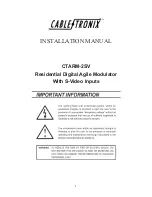
Remote Operations
QAM256 Digital Video Modulator and Upconverter
C-4
TM077 – Rev. 4.0
and recognizes that the message is a duplicate, so the associated commands within the packet
are not executed a second time. However, the response packet is again sent back to the source,
as an acknowledgment in order to preclude undesired multiple executions of the same command.
To reiterate, valid equipment responses to a message require the FSN tag in the command
packet. This serves as part of the handshake/acknowledge routine. If a valid response message
is absent, then the command is re-transmitted with the same FSN. For a repeat of the same
command involving iterative processes (such as increasing or decreasing transmit power level of
a QAM256), the FSN is incremented after each message packet.
When the FSN value reaches
255, it overflows and begins again at zero. The FSN tag is a powerful tool that assures sequential
information framing, and is especially useful where commands require more than one message
packet.
The full handshake/acknowledgment involves a reversal of source and destination ID codes in the
next message frame, followed by a response code in the <OPCODE> field of the message
packet from the equipment under control.
If a command packet is sent and not received at its intended destination, a timeout condition can
occur because the packet originator does not receive a response message. On receiving devices
slaved to an M & C computer, the timeout delay parameters may be programmed into the
equipment in accordance with site requirements by Radyne Corp. prior to shipment, or altered by
qualified personnel. The FSN handshake routines must account for timeout delays and be able to
introduce them as well.
C.1.4 Global Response Operational Codes
In acknowledgment (response) packets, the operational code <OPCODE> field of the message
packet is set to 0 by the receiving devices when the message intended for the device is evaluated
as valid. The device that receives the valid message then exchanges the <SOURCE ID> with the
<DESTINATION ID>, sets the <OPCODE> to zero in order to indicate that a good message was
received, and returns the packet to the originator. This "GOOD MESSAGE" Opcode is one of
nine global responses. Global response Opcodes are common responses, issued to the M&C
computer or to another device, which can originate from and are interpreted by all Radyne
equipment in the same manner. These are summarized as follows (all Opcode values are
expressed in decimal form):
RESPONSE OPCODE DESCRIPTION
OPCODE
Good Message
0000
Invalid Size
0001
Unknown Error
0002
Invalid Control Mode
0003
Invalid Parameter
0004
Invalid Last Rate Mode
0005
Invalid Symbol Rate (Symbol Rate
Low)
0006
Invalid Symbol Rate (Symbol Rate
High)
0007
Invalid Symbol Rate (Data Rate Low)
0008
Invalid Symbol Rate (Data Rate Low)
0009
Invalid Framing
000A
Invalid Modulation
000B
Invalid Interleaver/Encoder
000D
Table 2. Response OPCODES
Summary of Contents for QAM256
Page 9: ...Table of Contents QAM256 Digital Video Modulator and Upconverter x TM077 Rev 4 0...
Page 11: ...Introduction QAM256 Digital Video Modulator and Upconverter 1 2 TM077 Rev 4 0...
Page 14: ...QAM256 Digital Video Modulator and Upconverter Installation TM077 Rev 4 0 2 3...
Page 16: ...Theory of Operation QAM256 Digital Video Modulator and Upconverter 3 2 TM077 Rev 4 0...
Page 32: ...User Interfaces QAM256 Digital Video Modulator and Upconverter 4 16 TM077 Rev 4 0...
Page 39: ...QAM256 Digital Video Modulator and Upconverter Rear Panel Interfaces TM077 Rev 4 0 5 7...
Page 44: ...QAM256 Digital Video Modulator and Upconverter Technical Specifications TM077 Rev 4 0 7 3...
Page 46: ...Product Options QAM256 Digital Video Modulator and Upconverter A 2 TM077 Rev 4 0...
Page 55: ...QAM256 Digital Video Modulator and Upconverter SNMP MIB TM077 Rev 4 0 B 9...
Page 81: ...Remote Operations QAM256 Digital Video Modulator and Upconverter C 26 TM077 Rev 4 0...
















































